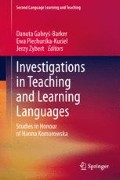Abstract
Various aspects of foreign language didactics as a discipline have been in focus of my interest: the field’s characteristics as a relatively autonomous (as opposed to primarily interdisciplinary) academic endeavor in search of understanding; the field’s constitution as a science as opposed to pre-science or language teaching methodology; the meaning of “normal science” at the time of questioning the cognitive power of sciences; and last, but not least, the field’s properties as an empirical scientific discipline with pure and applied goals. Constraints resulting from the above considerations justify a bottom-up strategy of modeling the field’s subject matter. In contrast to the influential linguistically-driven top-down strategy, this means targeting human beings who use language in verbal communication, i.e. act as producers and comprehenders of verbal messages in speech and writing (Balconi ed. 2010). The fact that the subject matter of foreign language didactics is constituted by human subjects involved in language use brings us to the main question of the article: What is the significance of this modeling strategy for the overall characterization of language use in foreign language didactics as a subfield of humanities. The article lists and discusses nineteen properties of language use in this decentered, humanly anchored perspective in clear contrast with the view of language as a formal system unfolding in time, influential in the earlier stages of foreign language research. The ensuing characteristics cluster around such more general issues as the whole-person involvement in verbal communication; life-span development of language use; the centrality of meaning and its constructive and evaluative nature. The nineteen features resulting from the bottom-up modeling strategy selected for the field of foreign language teaching provide further support for discriminating between the criteria of science in the hard or natural sciences and in the humanities.
Access this chapter
Tax calculation will be finalised at checkout
Purchases are for personal use only
References
Aitkenhead, A. M. and J. M. Slack eds. 1987. Issues in cognitive modelling. London: Lawrence Erlbaum Ass.
Anderson, B. F. 1975. Cognitive psychology. The study of knowing, learning and thinking. New York: Academic Press.
Anderson, J. R. 1983. The architecture of cognition. Cambridge, MA.: Harvard University Press.
Anderson, J. R. 1985. Cognitive psychology and its implications. New York: W. H. Freeman and Co.
Baars, B. J. 1997. In the theatre of consciousness. The workspace of the mind. Oxford: Oxford University Press.
Baars, B. J. and N. M. Gage eds. 2007. Cognition, brain, and consciousness. Introduction to cognitive neuroscience. Amsterdam: Academic Press.
Balconi, M. (ed.). 2010. Neuropsychology of communication. Milan: Springer.
Barsalou, L. 2009. Cognitive Psychology. An overview for cognitive scientists. New York: Psychology Press.
Benjafield, J. G. 1992. Cognition. Englewood Cliffs, N.J.: Prentice Hall.
Carroll, D. W. 1986. Psychology of language. Monterey, CA: Brooks/Cole Publ.
Dakowska, M. 1993. Language, metalanguage and language use. International Journal of Applied Linguistics 3: 79–100.
Dakowska, M. 1996. Models of language use and language learning in the theory of foreign language didactics. Frankfurt am Main: Peter Lang.
Dakowska, M. 1997. Cognitive modelling of Second Language Acquisition. Communication and Cognition 30, Special issue: Communication, Cognition, and Second Language Acquisition, 29–53.
Dakowska, M. 2000. Mechanizm czy organizm? Dwa bieguny modelowania akwizycji języków obcych [Mechanism or organism? Two poles of modeling second language acquisition]. In Problemy komunikacji międzykulturowej, ed. B. Kielar, J. Lewandowski, J. Lukszyn i T. P. Krzeszowski , 335–351. Warszawa: Grafpunkt.
Dakowska, M. 2003. Current controversies in foreign language didactics. Warszawa: University of Warsaw Press.
Dakowska, M. 2010. Kognitywna koncepcja nauki a glottodydaktyka [A cognitive conception of science and glottodidactics]. In: Translatoryka. Koncepcje – Modele – Analizy, ed. S. Grucza, A. Marchwiński and M. Płużyczka, 41–53. Warszawa: University of Warsaw Press.
Doughty, C. J. and M. H. Long, (eds). 2003. The handbook of Second Language Acquisition. Malden: Blackwell.
Eysenck, M. W. 2006. Fundamentals of cognition. Hove and New York: Psychology Press.
Eysenck, M. W. and M. T. Keane. 1995. Cognitive psychology. A student’s handbook. Hove: Psychology Press.
Giere, R. 1988. Explaining science. A cognitive approach. Chicago: The University of Chicago Press.
Giere, R. 1999. Science without laws. Chicago: The University of Chicago Press.
Giere, R. 2006. Scientific perspectivism. Chicago: The University of Chicago Press.
Giere, R. (ed.). 1992. Cognitive models of science. Minneapolis: The University of Minnesota Press.
Gillet, G. R. and J. McMillan, 2001. Consciousness and intentionality. Amsterdam: John Benjamins.
Hewes, D. E. 1995. The cognitive bases of interpersonal communication. Hillsdale, N.J.: Lawrence Erlbaum Ass.
Jay, T. B. 2002. The psychology of language. Upper Saddle, N.J.: Prentice Hall.
Koch, C. 2004. The quest for consciousness. A neurobiological approach. Englewood, Co.: Roberts and Co. Publishers.
Kuhn, T., 1962. The structure of scientific revolutions. Chicago: The University of Chicago Press.
Lindsay, P. H. i D. A. Norman. 1991. Procesy przetwarzania informacji u człowieka [Human information processing]. Warszawa: Wydawnictwo Naukowe PWN.
Matlin, M. W. 1994. Cognition. Fort Worth: Harcourt and Brace.
McLaughlin, B. 1990. Restructuring. Applied Linguistics 11: 113–128.
Nęcka, E., J. Orzechowski and B. Szymura. 2006. Psychologia poznawcza [Cognitive psychology]. Warszawa: Wydawnictwo Naukowe PWN.
Selinker, L. 1972. Interlanguage. International Review of Applied Linguistics 231.
Solso, R. L. 1998. Cognitive psychology. Boston: Allyn and Bacon.
Sternberg, R. J. 1996. Cognitive psychology. Fort Worth: Harcourt Brace.
Thagard, P. 2005. Mind. Introduction to cognitive science. Cambridge, MA: The MIT Press.
Author information
Authors and Affiliations
Corresponding author
Editor information
Editors and Affiliations
Rights and permissions
Copyright information
© 2013 Springer International Publishing Switzerland
About this chapter
Cite this chapter
Dakowska, M. (2013). Foreign Language Didactics as a Human Science. In: Gabryś-Barker, D., Piechurska-Kuciel, E., Zybert, J. (eds) Investigations in Teaching and Learning Languages. Second Language Learning and Teaching. Springer, Heidelberg. https://doi.org/10.1007/978-3-319-00044-2_3
Download citation
DOI: https://doi.org/10.1007/978-3-319-00044-2_3
Published:
Publisher Name: Springer, Heidelberg
Print ISBN: 978-3-319-00043-5
Online ISBN: 978-3-319-00044-2
eBook Packages: Humanities, Social Sciences and LawEducation (R0)

